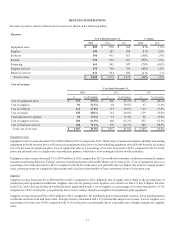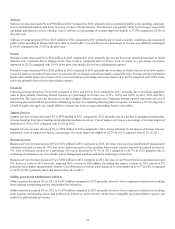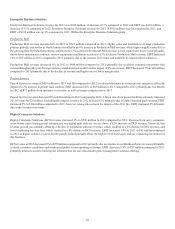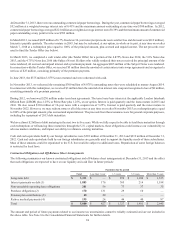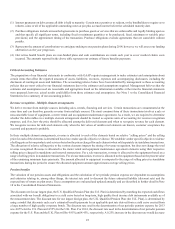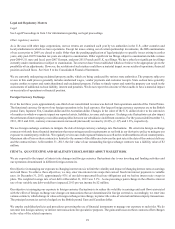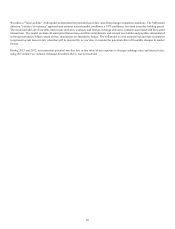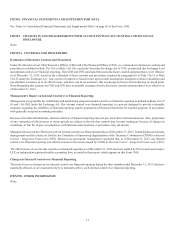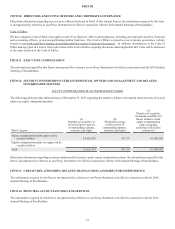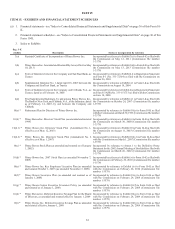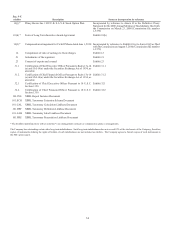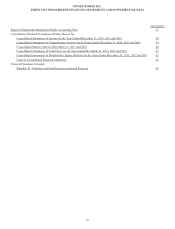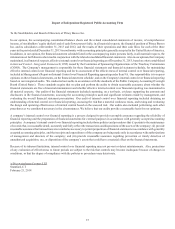Pitney Bowes 2013 Annual Report Download - page 38
Download and view the complete annual report
Please find page 38 of the 2013 Pitney Bowes annual report below. You can navigate through the pages in the report by either clicking on the pages listed below, or by using the keyword search tool below to find specific information within the annual report.27
of tax laws. The amount of reserves is adjusted when information becomes available or when an event occurs indicating a change in the
reserve is appropriate. Future changes in tax reserve requirements could have a material impact on our financial condition or results of
operations.
Significant judgment is also required in determining the amount of valuation allowance to be recorded against deferred tax assets. In
assessing whether a valuation allowance is necessary, and the amount of such allowance, we consider all available evidence for each
jurisdiction including past operating results, estimates of future taxable income and the feasibility of ongoing tax planning strategies. As
new information becomes available that would alter our determination as to the amount of deferred tax assets that will ultimately be
realized, we adjust the valuation allowance with a corresponding impact to income tax expense in the period in which such determination
is made.
Useful lives of long-lived assets
We depreciate property, plant and equipment and rental property and equipment principally using the straight-line method over the
estimated useful lives of up to 50 years for buildings, three to 15 years for machinery and equipment, four to six years for rental equipment
and three to five years for computer equipment. Leasehold improvements are amortized over the shorter of the estimated useful life or
the remaining lease term. We amortize capitalized costs related to internally developed software using the straight-line method over the
estimated useful life, which is principally three to 10 years. Intangible assets with finite lives are amortized using the straight-line method
or an accelerated attrition method over their estimated useful lives, which are principally three to 15 years. Our estimates of useful lives
could be affected by changes in regulatory provisions, technology or business plans and changes to the assets' estimated useful lives could
have a material impact on our results of operations.
Impairment review
Long-lived and intangible assets are reviewed for impairment whenever events or changes in circumstances indicate that the carrying
amount may not be fully recoverable. The related estimated future undiscounted cash flows expected to result from the use and eventual
disposition of the asset is compared to the asset's carrying amount. We derive the cash flow estimates from our future long-term business
plans and historical experience. If the sum of the expected cash flows is less than the carrying amount, an impairment charge is recorded
for an amount by which the carrying amount exceeds the fair value of the asset. The fair value of the asset is determined using probability
weighted expected discounted cash flow estimates, quoted market prices when available and appraisals, as appropriate. Changes in the
estimates and assumptions incorporated in our impairment assessment could materially affect the determination of fair value and the
associated impairment charge.
Goodwill is tested annually for impairment, during the fourth quarter, or sooner when circumstances indicate an impairment may exist
at the reporting unit level. The impairment test for goodwill is a two-step approach. In the first step, the fair value of each reporting unit
is compared to the reporting unit's carrying value, including goodwill. If the fair value of a reporting unit is less than its carrying value,
the second step of the goodwill impairment test is performed to measure the amount of impairment, if any. In the second step, the fair
value of the reporting unit is allocated to the assets and liabilities of the reporting unit as if it had been acquired in a business combination
and the purchase price was equivalent to the fair value of the reporting unit. The excess of the fair value of the reporting unit over the
amounts assigned to its assets and liabilities is referred to as the implied fair value of goodwill. The implied fair value of the reporting
unit's goodwill is then compared to the actual carrying value of goodwill. If the implied fair value of goodwill is less than the carrying
value of goodwill, an impairment loss is recognized for the difference.
Significant estimates and assumptions are used in our goodwill impairment review and include the identification of reporting units,
assigning assets and liabilities to reporting units, assigning goodwill to reporting units and determining the fair value of each reporting
unit. The fair value of each reporting unit is determined based on a combination of techniques, including the present value of future cash
flows, applicable multiples of competitors and multiples from sales of like businesses. The assumptions used to estimate fair value are
based on projections incorporated in our current operating plans as well as other available information. Our operating plans include
significant assumptions and estimates associated with sales growth, profitability and related cash flows, along with cash flows associated
with taxes and capital spending. The determination of fair value also incorporates a risk-adjusted discount rate based on current interest
rates and the economic conditions of the reporting unit. We consider other assumptions that market participants may use. Changes in
any of these estimates or assumptions could materially affect the determination of fair value and the associated goodwill impairment
charge for each reporting unit. Potential events and circumstances, such as the inability to acquire new clients, downward pressures on
pricing and rising interest rates could have an adverse impact on our assumptions and result in non-cash impairment charges in future
periods.
Based on the results of the annual impairment test performed during the fourth quarter of 2013, we determined that the estimated fair
value of each of the reporting units exceeded their carrying value by 20% or more, except for the software and direct marketing operations
of our DCS segment. The estimated fair value of the software reporting unit exceeded its carrying value by 12% and the estimated fair


